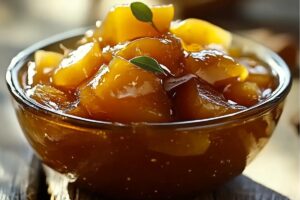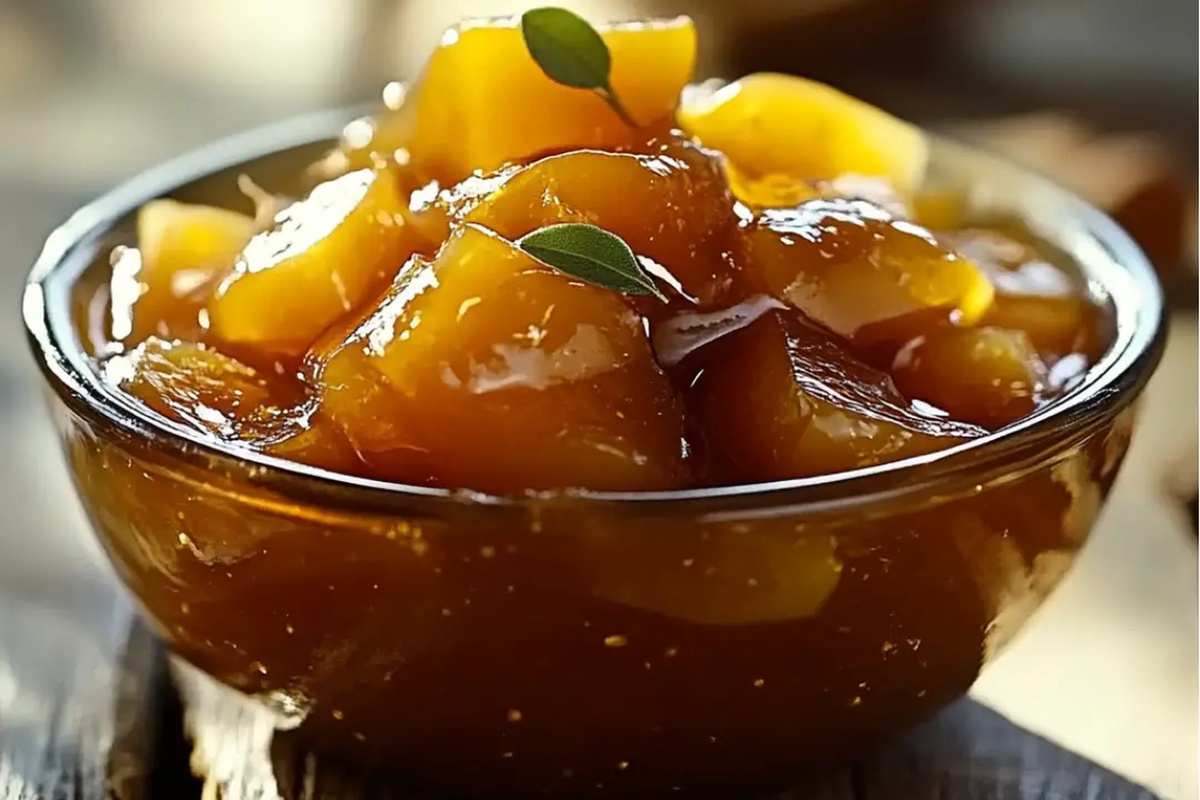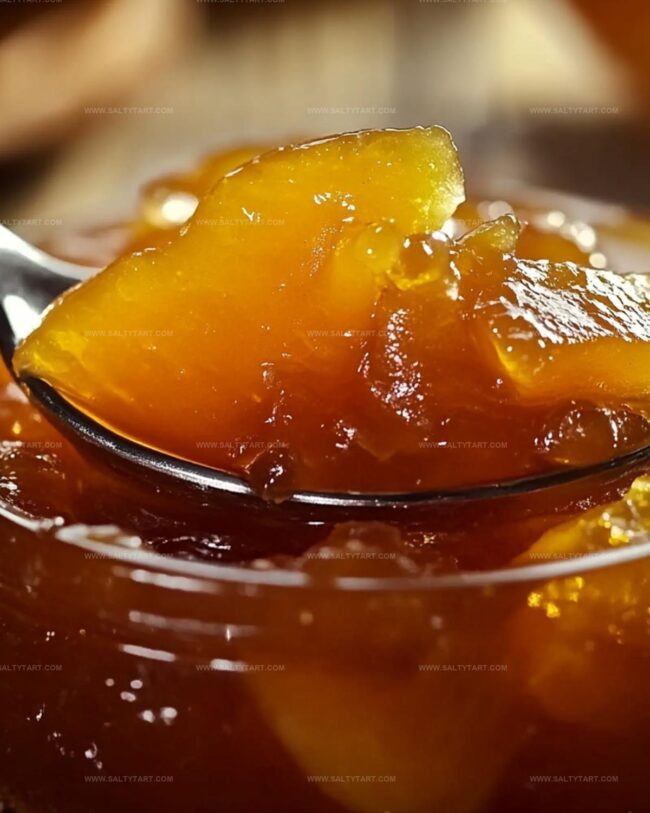Heavenly Quince and Honey Marmalade Recipe for Cozy Mornings
Preserving summer’s golden bounty, this delightful quince and honey marmalade captures the essence of seasonal sweetness.
Fragrant quinces burst with complex flavors when slowly simmered with rich, golden honey.
The deep amber preserve sparkles with natural sugars and delicate floral notes.
Each spoonful tells a story of rustic kitchen magic and careful crafting.
Artisan techniques transform humble fruits into a spreadable treasure that sings of late harvest mornings.
You’ll find this marmalade dancing perfectly on warm toast or stirred into morning yogurt.
Let this recipe be your gateway to a world of homemade preserve perfection.
Quince Honey Marmalade With Old World Charm
Quince Honey Marmalade Ingredient Checklist
Main Ingredients:Acidic Ingredient:Equipment and Preparation Ingredients:Steps for Making Quince Honey Marmalade
Step 1: Softening Quince
Place quince slices in a large pot or Dutch oven. Cover with water and bring to a boil over medium-high heat.
Lower temperature to medium-low and gently simmer until quince becomes incredibly tender and easily mashable, which typically takes around 60 minutes.
Step 2: Transforming Texture
Using a potato masher or immersion blender, thoroughly mash the quince until achieving a smooth, consistent texture.
Step 3: Sweetening the Mixture
Add these ingredients to the pot:Bring the mixture to a boil over medium heat. Reduce heat to low and allow to simmer for approximately 30 minutes, or until the marmalade reaches your preferred thickness.
Step 4: Checking Marmalade Readiness
Test marmalade’s doneness by placing a small amount on a chilled plate. Allow it to cool briefly.
Gently slide your finger across the surface. When the marmalade wrinkles upon touch, it indicates perfect consistency.
Step 5: Preserving the Marmalade
Allow marmalade to cool slightly. Carefully pour into sterilized glass jars.
Seal jars completely. Store in a cool, dark location for up to six months.
Good Notes for Marmalade Cooking Success
New Styles for Quince Honey Marmalade
What to Serve With Quince Honey Marmalade
Marmalade Storage for Sweetness That Lasts
FAQs
Quinces are yellow fruit related to apples and pears, native to the Caucasus region in Southwest Asia. They have a hard, fragrant flesh that becomes soft and sweet when cooked, making them perfect for jams and marmalades.
Quinces have a tough texture and high pectin content that requires long, slow cooking to break down the fibers and develop their rich, complex flavor. This process transforms the hard fruit into a smooth, delicious spread.
While honey adds a unique flavor, you can substitute with white sugar or maple syrup. However, each sweetener will slightly alter the taste and texture of the marmalade, so honey provides the most traditional and authentic result.
Print
Quince And Honey Marmalade Recipe
- Total Time: 1 hour 45 minutes
- Yield: 6 1x
Description
Sweet quince and honey marmalade weaves Mediterranean magic into a delightful preserve. Fragrant golden spread promises winter comfort with delicate fruit notes and golden honey essence you’ll savor slowly.
Ingredients
Main Ingredients:
- 2 pounds (907 grams) quince, peeled, cored, and sliced
- 1 bag (12 ounces/340 grams) frozen honey
Liquid Ingredients:
- 3 cups (710 milliliters) water
- 1/4 cup (60 milliliters) lemon juice
Instructions
- Wash and slice quince into uniform pieces, removing seeds and core.
- Transfer quince to a large pot, cover with water, and heat to a rolling boil over medium-high temperature.
- Reduce heat to medium-low, allowing quince to simmer gently for approximately 60 minutes until extremely tender and easily crushable.
- Utilize a potato masher or immersion blender to transform quince into a smooth, consistent puree.
- Incorporate honey and freshly squeezed lemon juice into the quince mixture, stirring thoroughly.
- Return the mixture to medium heat, bringing it to a vigorous boil, then immediately lower temperature to a gentle simmer.
- Continue cooking for 30 minutes, stirring periodically to prevent scorching and achieve desired thick consistency.
- Verify marmalade’s readiness by conducting a quick gel test: drop a small amount on a chilled plate and allow to cool for 60 seconds.
- Gently run a finger through the cooled sample; if the surface creates a wrinkled texture, the marmalade has reached perfect setting point.
- Allow marmalade to cool slightly, then carefully transfer into sterilized glass containers.
- Seal jars tightly and store in a cool, dark environment for optimal preservation up to 6 months.
Notes
- Choose ripe, fragrant quinces for the most intense flavor and best texture in your marmalade.
- Test marmalade’s thickness by chilling a small plate beforehand to get an accurate consistency check.
- Use raw, unfiltered honey for a deeper, more complex sweetness that complements the quince’s natural tartness.
- Consider adding warm spices like cinnamon or cardamom for an extra layer of aromatic complexity in the preserve.
- Prep Time: 15 minutes
- Cook Time: 1 hour 30 minutes
- Category: Breakfast, Snacks, Desserts
- Method: Simmering
- Cuisine: British
Nutrition
- Serving Size: 6
- Calories: 75 kcal
- Sugar: 18 g
- Sodium: 2 mg
- Fat: 0.1 g
- Saturated Fat: 0 g
- Unsaturated Fat: 0.1 g
- Trans Fat: 0 g
- Carbohydrates: 20 g
- Fiber: 2 g
- Protein: 0.3 g
- Cholesterol: 0 mg



Jess Martinez
Contributing Recipe Writer & Nutrition Consultant
Expertise
Southwestern and Latin American cooking, Nutritional analysis and healthy recipe planning, Cultural food traditions, Modifying traditional dishes for better health
Education
Santa Fe Community College
Certificate in Culinary Arts
Focused on mastering the flavors and cooking methods of traditional Southwestern cuisine.
Jess’s love for bold, homegrown flavors led her straight into the world of Southwestern cooking and cultural nutrition.
After completing her Certificate in Culinary Arts at Santa Fe Community College, she made it her mission to show that good-for-you food can still taste incredible.
At saltytart.com, Jess shares vibrant, health-conscious recipes with roots in tradition but a fresh, modern twist. When she’s not testing new recipes, you’ll find her at local growers’ markets, tending her herb garden, or digging into food history books.